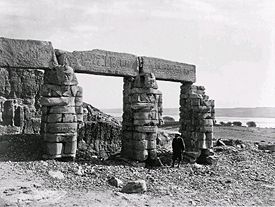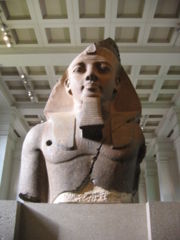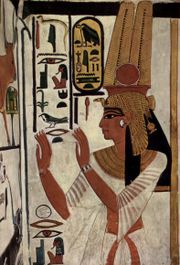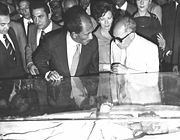Ramesses II
2008/9 Schools Wikipedia Selection. Related subjects: Ancient History, Classical History and Mythology
| Ramesses II | |||
|---|---|---|---|
| Ramesses the Great alternatively transcribed as Ramses and Rameses |
|||
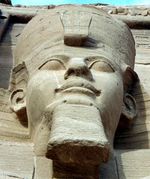 |
|||
| Ramesses II: one of four external seated statues at Abu Simbel | |||
| Pharaoh of Egypt | |||
| Reign | 1279–1213 BC, 19th Dynasty | ||
| Predecessor | Seti I | ||
| Successor | Merneptah | ||
|
Royal titulary
|
|||
| Consort(s) | Henutmire, Isetnofret, Nefertari, Maathorneferure | ||
| Children | Khaemweset, Merneptah, Amun-her-khepsef, Meritamen. See also: List of children of Ramesses II |
||
| Father | Seti I | ||
| Mother | Queen Tuya | ||
| Born | 1303 BC | ||
| Died | 1213 BC | ||
| Burial | KV7 | ||
| Monuments | Abu Simbel, Ramesseum, Luxor and Karnak temples | ||
Ramesses II (also known as Ramesses The Great and alternatively transcribed as Ramses and Rameses *Riʕmīsisu; also known as Ozymandias in the Greek sources, from a transliteration into Greek of a part of Ramesses' throne name, User-maat-re Setep-en-re) was the third Egyptian pharaoh of the Nineteenth dynasty. He is often regarded as Egypt's greatest and most powerful pharaoh. Ancient Greek writers such as Herodotus attributed his accomplishments to the semi-mythical Sesostris. He is traditionally believed to have been the Pharaoh of the Exodus.
He was born around 1303 BC and at age fourteen, Ramesses was appointed Prince Regent by his father Seti I. He is believed to have taken the throne in his early 20s and to have ruled Egypt from 1279 BC to 1213 BC for a total of 66 years and 2 months, according to Manetho. He was once said to have lived to be 99 years old, but it is more likely that he died in his 90th or 91st year. If he became king in 1279 BC as most Egyptologists today believe, he would have assumed the throne on May 31, 1279 BC, based on his known accession date of III Shemu day 27. Ramesses II celebrated an unprecedented 14 sed festivals during his reign—more than any other pharaoh. On his death, he was buried in a tomb in the Valley of the Kings; his body was later moved to a royal cache where it was discovered in 1881, and is now on display in the Cairo Museum.
As king, Ramesses II led several expeditions north into the lands east of the Mediterranean (the location of the modern Israel, Lebanon and Syria). He also led expeditions to the south, into Nubia, commemorated in inscriptions at Beit el-Wali and Gerf Hussein.
The early part of his reign was focused on building cities, temples and monuments. He established the city of Pi-Ramesses in the Nile Delta as his new capital and main base for his campaigns in Syria. This city was built on the remains of the city of Avaris, the capital of the Hyksos when they took over, and was the location of the main Temple of Set.
Family and life
Ramesses II was the third king of the 19th dynasty, and the second child of Seti I and his Queen Tuya. His only definite sibling was Princess Tia, although Henutmire, one of his Great Royal Wives, may have been his younger half-sister.
Ramesses had numerous consorts, the most famous being Nefertari. During his long reign, eight women held the title Great Royal Wife (often simultaneously): Nefertari and Isetnofret, whom he married early in his reign; Bintanath, Meritamen and Nebettawy, his own daughters who replaced their mothers Nefertari and Isetnofret when they died or retired; Henutmire; Maathorneferure, Princess of Hatti and another Hittite princess whose name is unknown.
The writer Terence Gray stated in 1923 that Ramesses II had as many as 20 sons and 20 daughters but scholars today believe his offspring numbered over 100. In 2004, Dodson and Hilton noted that the monumental evidence "seems to indicate that Ramesses II had around 110 children, [with] 48–55 sons and 40–53 daughters." His children include Bintanath and Meritamen (princesses and their father's wives), Sethnakhte, Amun-her-khepeshef the king's first born son, Merneptah (Ramesses' 13th son, who would eventually succeed him), and Prince Khaemweset. Ramesses II's second born son, Ramesses B, sometimes called Ramesses Junior, became the crown prince from Year 25 to Year 50 of his father's reign after the death of Amen-her-khepesh.
Campaigns and battles
Early in his life, Ramesses II embarked on numerous campaigns to return previously held territories back to Egyptian hands and to secure Egypt's borders. He was also responsible for suppressing some Nubian revolts and carrying out a campaign in Libya. Although the famous Battle of Kadesh often dominates the scholarly view of Ramesses II's military prowess and power, he nevertheless enjoyed more than a few outright victories over the enemies of Egypt.
Battle against Sherden sea pirates
In his second year, Ramesses II decisively defeated the Shardana or Sherden sea pirates who were wreaking havoc along Egypt's Mediterranean coast by attacking cargo-laden vessels travelling the sea routes to Egypt. The Sherden people probably came from the coast of Ionia or possibly south-west Turkey. Ramesses posted troops and ships at strategic points along the coast and patiently allowed the pirates to attack their prey before skillfully catching them by surprise in a sea battle and capturing them all in a single action. A stela from Tanis speaks of their having come "in their war-ships from the midst of the sea, and none were able to stand before them". There must have been a naval battle somewhere near the mouth of the Nile, as shortly afterwards many Sherden are seen in the Pharaoh's body-guard where they are conspicuous by their helmets with horns with a ball projecting from the middle, their round shields and the great Naue II swords with which they are depicted in inscriptions of the Battle of Kadesh.
First Syrian campaign
The immediate antecedents to the Battle of Kadesh were the early campaigns of Ramesses II into Canaan and Palestine. His first campaign seems to have taken place in the fourth year of his reign and was commemorated by the erection of a stela near modern Beirut. The inscription is almost totally illegible due to weathering. His records tell us that he was forced to fight a Palestinian prince who was mortally wounded by an Egyptian archer, and whose army was subsequently routed. Ramesses carried off the princes of Palestine as live prisoners to Egypt. Ramesses then plundered the chiefs of the Asiatics in their own lands, returning every year to his headquarters at Riblah to exact tribute. In the fourth year of his reign, he captured the Hittite vassal state of Amurru during his campaign in Syria.
Second Syrian campaign
The Battle of Kadesh in his fifth regnal year was the climatic engagement in a campaign that Ramesses fought in Syria, against the resurgent Hittite forces of Muwatalli. The pharaoh wanted a victory at Kadesh both to expand Egypt's frontiers into Syria and to emulate his father Seti I's triumphal entry into the city just a decade or so earlier. He also constructed his new capital, Pi-Ramesses where he built factories to manufacture weapons, chariots, and shields. Of course, they followed his wishes and manufactured some 1,000 weapons in a week, about 250 chariots in 2 weeks, and 1,000 shields in a week and a half. After these preparations, Ramesses moved to attack territory in the Levant which belonged to a more substantial enemy than any he had ever faced before: the Hittite Empire.
Although Ramesses's forces were caught in a Hittite ambush and outnumbered at Kadesh, the pharaoh fought the battle to a stalemate and returned home a hero. Ramesses II's forces suffered major losses particularly among the 'Re' division which was routed by the initial charge of the Hittite chariots during the battle. Once back in Egypt, Ramesses proclaimed that he had won a great victory, but in reality all he had managed to do was to save his army from destruction. In a sense, however, the Battle of Kadesh was a personal triumph for Ramesses, as after blundering into a devastating Hittite ambush, the young king courageously rallied his scattered troops to fight on the battlefield while escaping death or capture. While the pharaoh claimed that he had won the battle, the victory was a pyrrhic one, and he was unable to occupy the city or territory around Kadesh.
Ramesses decorated his monuments with reliefs and inscriptions describing the campaign as a whole, and the battle in particular as a major victory. Inscriptions of his victory decorate the Ramesseum, Abydos, Karnak, Luxor and Abu Simbel. For example, on the temple walls of Luxor the near catastrophe was turned into an act of heroism:
His majesty slaughtered the armed forces of the Hittites in their entirety, their great rulers and all their brothers ... their infantry and chariot troops fell prostrate, one on top of the other. His majesty killed them ... and they lay stretched out in front of their horses. But his majesty was alone, nobody accompanied him ...
Third Syrian campaign
Egypt's sphere of influence was now restricted to Canaan while Syria fell into Hittite hands. Canaanite princes, seemingly influenced by the Egyptian incapacity to impose their will, and goaded on by the Hittites, began revolts against Egypt. In the seventh year of his reign, Ramesses II returned to Syria once again. This time he proved more successful against his Hittite foes. During this campaign he split his army into two forces. One was led by his son, Amun-her-khepeshef, and it chased warriors of the Šhasu tribes across the Negev as far as the Dead Sea, and captured Edom-Seir. It then marched on to capture Moab. The other force, led by Ramesses, attacked Jerusalem and Jericho. He, too, then entered Moab, where he rejoined his son. The reunited army then marched on Hesbon, Damascus, on to Kumidi, and finally recaptured Upi.
Later campaigns in Syria
Ramesses extended his military successes in his eighth and ninth years. He crossed the Dog River (Nahr el-Kelb) and pushed north into Amurru. His armies managed to march as far north as Dapur, where he erected a statue of himself. The Egyptian pharaoh thus found himself in northern Amurru, well past Kadesh, in Tunip, where no Egyptian soldier had been seen since the time of Thutmose III almost 120 years earlier. He laid siege on the city before capturing it. His victory proved to be ephemeral. In year nine, Ramesses erected a stela at Beth Shean. After having reasserted his power over Canaan, Ramesses led his army north. A mostly illegible stela near Beirut, which appears to be dated to the king's second year, was probably set up there in his tenth. The thin strip of territory pinched between Amurru and Kadesh did not make for a stable possession. Within a year, they had returned to the Hittite fold, so that Ramesses had to march against Dapur once more in his tenth year. This time he claimed to have fought the battle without even bothering to put on his corslet until two hours after the fighting began. Six of Ramesses' sons, still wearing their side locks, took part in this conquest. He took towns in Retenu, and Tunip in Naharin, later recorded on the walls of the Ramesseum. This second success here was equally as meaningless as his first, as neither power could decisively defeat the other in battle.
Peace treaty with the Hittites
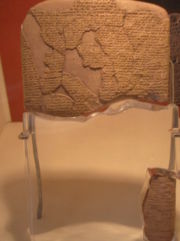
The deposed Hittite king, Mursili III fled to Egypt, the land of his country's enemy, after the failure of his plots to oust his uncle from the throne. Hattusili III responded by demanding that Ramesses II extradite his nephew back to Hatti.
This demand precipitated a crisis in relations between Egypt and Hatti when Ramesses denied any knowledge of Mursili's whereabouts in his country, and the two Empires came dangerously close to war. Eventually, in the twenty-first year of his reign ( 1258 BC), Ramesses decided to conclude an agreement with the new Hittite king at Kadesh, Hattusili III, to end the conflict. The ensuing document is the earliest known peace treaty in world history.
The peace treaty was recorded in two versions, one in Egyptian hieroglyphs, the other in Akkadian, using cuneiform script; both versions survive. Such dual-language recording is common to many subsequent treaties. This treaty differs from others however, in that the two language versions are differently worded. Although the majority of the text is identical, the Hittite version claims that the Egyptians came suing for peace, while the Egyptian version claims the reverse. The treaty was given to the Egyptians in the form of a silver plaque, and this "pocket-book" version was taken back to Egypt and carved into the Temple of Karnak.
The treaty was concluded between Ramesses II and Hattusili III in Year 21 of Ramesses' reign. (c. 1258 BC) Its 18 articles call for peace between Egypt and Hatti and then proceeds to maintain that their respective gods also demand peace. The frontiers are not laid down in this treaty but can be inferred from other documents. The Anastasy A papyrus describes Canaan during the latter part of the reign of Ramesses II and enumerates and names the Phoenician coastal towns under Egyptian control. The harbour town of Sumur north of Byblos is mentioned as being the northern-most town belonging to Egypt, which points to it having contained an Egyptian garrison.
No further Egyptian campaigns in Canaan are mentioned after the conclusion of the peace treaty. The northern border seems to have been safe and quiet, so the rule of the pharaoh was strong until Ramesses II's death, and the waning of the dynasty. When the King of Mira attempted to involve Ramesses in a hostile act against the Hittites, the Egyptian responded that the times of intrigue in support of Mursili III, had passed. Hattusili III wrote to Kadashman-Enlil II, King of Karduniash ( Babylon) in the same spirit, reminding him of the time when his father, Kadashman-Turgu, had offered to fight Ramesses II, the king of Egypt. The Hittite king encouraged the Babylonian to oppose another enemy, which must have been the king of Assyria whose allies had killed the messenger of the Egyptian king. Hattusili encouraged Kadashman-Enlil to come to his aid and prevent the Assyrians from cutting the link between the Canaanite province of Egypt and Mursili III, the ally of Ramesses.
Campaigns in Nubia
Ramesses II also campaigned south of the first cataract into Nubia. When Ramesses was about 22, two of his own sons, including Amun-her-khepeshef, accompanied him in at least one one of those campaigns. By the time of Ramesses, Nubia had been a colony for two hundred years, but its conquest was recalled in decoration from the temples Ramesses II built at Beit el-Wali (which was the subject of epigraphic work by the Oriental Institute during the Nubian salvage campaign of the 1960s), Gerf Hussein and Kalabsha in northern Nubia.
Campaigns in Libya
During the reign of Ramesses II, there is evidence that the Egyptians were active for a 300-kilometre (190 mi) stretch along the Mediterranean coast, at least as far as Zawiyet Umm el-Rakham. Although the exact events surrounding the foundation of the coastal forts and fortresses is not clear, some degree of political and military control must have been held over the region to allow their construction.
There are no detailed accounts of Ramesses II undertaking large military actions against the Libyans, only generalised records of his conquering and crushing them, which may or may not refer to specific events, otherwise unrecorded. It may be that some of the records, such as the Aswan Stela of his year 2, are harking back to Ramesses' presence on his father's Libyan campaigns. Perhaps it was Seti I who achieved this proposed control over the region, and it was he who planned to establish the defensive system, in a manner similar to which he rebuilt those to the east, the Ways of Horus across Northern Sinai.
Religious impact
Ramesses was the pharaoh most responsible for erasing the Amarna period from history. He, more than any other pharaoh, sought deliberately to deface the Amarna monuments and change the nature of the religious structure and the structure of the priesthood, in order to try to bring it back to where it had been prior to the reign of Akhenaten.
Sed festival
After reigning for 30 years, Ramesses joined a selected group that included only a handful of Egypt's longest-lived kings. By tradition, in the 30th year of his reign Ramesses celebrated a jubilee called the Sed festival, during which the king was ritually transformed into a god. Only halfway through what would be a 66-year reign, Ramesses had already eclipsed all but a few greatest kings in his achievements. He had brought peace, maintained Egyptian borders and built great and numerous monuments across the empire. His country was more prosperous and powerful than it had been in nearly a century. By becoming a god, Ramesses dramatically changed not just his role as ruler of Egypt, but also the role of his firstborn son, Amun-her-khepsef. As the chosen heir and commander and chief of Egyptian armies, his son effectively became ruler in all but name.
Building activity and monuments
Ramesses built extensively throughout Egypt and Nubia, and his cartouches are prominently displayed even in buildings that he did not actually construct. There are accounts of his honour hewn on stone, statues, remains of palaces and temples, most notable the Ramesseum in the western Thebes and the rock temples of Abu Simbel. He covered the land from the Delta to Nubia with buildings in a way no king before him had done. He also founded a new capital city in the Delta during his reign called Pi-Ramesses; it had previously served as a summer palace during Seti I's reign.
His memorial temple Ramesseum, was just the beginning of the pharaoh's obsession with building. When he built, he built on a scale unlike almost anything before. In the third year of his reign Ramesses started the most ambitious building project after the pyramids, that were built 1,500 years earlier. The population was put to work on changing the face of Egypt. In Thebes, the ancient temples were transformed, so that each one of them reflected honour to Ramesses as a symbol of this divine nature and power. Ramesses decided to eternalize himself in stone, and so he ordered changes to the methods used by his masons. The elegant but shallow reliefs of previous pharaohs were easily transformed, and so their images and words could easily be obliterated by their successors. Ramesses insisted that his carvings were deeply engraved in the stone, which made them not only less susceptible to later alteration, but also made them more prominent in the Egyptian sun, reflecting his relationship with the sun god, Ra.
Ramesses constructed many large monuments, including the archeological complex of Abu Simbel, and the mortuary temple known as the Ramesseum. He built on a monumental scale to ensure that his legacy would survive the ravages of time. Ramesses used art as a means of propaganda for his victories over foreigners and are depicted on numerous temple reliefs. Ramesses II also erected more colossal statues of himself than any other pharaoh. He also usurped many existing statues by inscribing his own cartouche on them.
Pi-Ramesses
Here once stood some of the greatest monuments and buildings that Ramesses was building all across Egypt. The city was called Pi-Ramesses Aa-nakhtu, meaning "Domain of Ramesses II, Great in Victory" Although Pi-Ramesses was mentioned and named in the Bible, as a site where the Israelites were forced to work hard for the pharaoh, for many centuries it was lost, considered nothing more than a myth. For a time it was misidentified as being in Tanis, due to the amount of statuary and other material from Pi-Ramesses found there. But after 20 years of excavation, it was finally found in the eastern Delta. Its foundations lie hidden several feet beneath lush farmland. The colossal feet of the statue of Ramesses are almost all that remains above ground today, the rest is buried in the fields. The ancient city was dominated by huge temples and the king's vast residential palace, complete with its own zoo. The city also had a massive chariot base, as described in the Bible.
Ramesseum
The temple complex built by Ramesses II between Qurna and the desert has been known as the Ramesseum since the 19th century. The Greek historian Diodorus Siculus marveled at the gigantic and famous temple, now no more than a few ruins.
Oriented northwest and southeast, the temple itself was preceded by two courts. An enormous pylon stood before the first court, with the royal palace at the left and the gigantic statue of the king looming up at the back. Only fragments of the base and torso remain of the syenite statue of the enthroned pharaoh, 17 metres (56 ft) high and weighing more than 1,000 tonnes (980 LT/1,100 ST). The scenes of the great pharaoh and his army triumphing over the Hittite forces fleeing before Kadesh, represented on the pylon. Remains of the second court include part of the internal facade of the pylon and a portion of the Osiride portico on the right. Scenes of war and the rout the Hittites at Kadesh are repeated on the walls. In the upper registers, feast and honour of the phallic god Min, god of fertility. On the opposite side of the court the few Osiride pillars and columns still left can furnish an idea of the original grandeur.
Scattered remains of the two statues of the seated king can also be seen, one in pink granite and the other in black granite, which once flanked the entrance to the temple. Thirty-nine out of the forty-eight columns in the great hypostyle hall (m 41x 31) still stand in the central rows. They are decorated with the usual scenes of the king before various gods. Part of the ceiling decorated with gold stars on a blue ground has also been preserved. Ramesses' children appear in the procession on the few walls left. The sanctuary was composed of three consecutive rooms, with eight columns and the tetrastyle cell. Part of the first room, with the ceiling decorated with astral scenes, and few remains of the second room are all that is left. Vast storerooms built in mud bricks stretched out around the temple. Traces of a school for scribes were found among the ruins.
A temple of Seti I, of which nothing is now left but the foundations, once stood to the right of the hypostyle hall.
Abu Simbel
In 1255 BC Ramesses and his queen Nefertari had traveled into Nubia to inaugurate a new temple, a wonder of the ancient world, the great Abu Simbel. It is an ego cast in stone; the man who built it intended not only to become Egypt's greatest pharaoh but also one of its gods.
The great temple of Ramesses II at Abu Simbel was discovered in 1813 by the famous Swiss Orientalist and traveler Johann Ludwig Burckhardt. However, four years passed before anyone could enter the temple, because an enormous pile of sand almost completely covered the facade and its colossal statues, blocking the entrance. This feat was achieved by the great Paduan explorer Giovanni Battista Belzoni, who managed to reach the interior on 4 August 1817.
Other Nubian monuments
As well as the famous temples of Abu Simbel, Ramesses left other monuments to himself in Nubia. His early campaigns are illustrated on the walls of Beit el-Wali (now relocated to New Kalabsha). Other temples dedicated to Ramesses are Derr and Gerf Hussein (also relocated to New Kalabsha).
Tomb of Nefertari
The important and famous of Ramesses' consorts was discovered by Ernesto Schiaparelli in 1904. Although it had been looted in ancient times, the tomb of Nefertari is extremely important, because its magnificent wall painting decoration is regarded as one of the greatest achievements of ancient Egyptian art. A flight of steps cut out of the rock gives access to the antechamber, which is decorated with paintings based on chapter 17 of the Book of the Dead. This astronomical ceiling represents the heavens and is painted in dark blue, with a myriad of golden five-pointed stars. The east wall of the antechamber is interrupted by a large opening flanked by representation of Osiris at left and Anubis at right; this in turn leads to the side chamber, decorated with offering scenes, preceded by a vestibule in which the paintings portray Nefertari being presented to the gods who welcome her. On the north wall of the antechamber is the stairway that goes down to the burial chamber. This latter is a vast quadrangular room covering a surface area of about 90 square metres (970 sq ft), the astronomical ceiling of which is supported by four pillars entirely covered with decoration. Originally, the queen's red granite sarcophagus lay in the middle of this chamber. According to religious doctrines of the time, it was in this chamber, which the ancient Egyptians called the golden hall that the regeneration of the deceased took place. This decorative pictogram of the walls in the burial chamber drew inspirations from chapters 144 and 146 of the Book of the Dead: in the left half of the chamber, there are passages from chapter 144 concerning the gates and doors of the kingdom of Osiris, their guardians, and the magic formulas that had to be uttered by the deceased in order to go past the doors.
Tomb KV5
In 1995, Professor Kent Weeks, head of the Theban Mapping Project rediscovered Tomb KV5. It has proven to be the largest tomb in the Valley of the Kings, and originally contained the mummified remains of some of this king's estimated 52 sons. Approximately 150 corridors and tomb chambers have been located in this tomb as of 2006 and the tomb may contain as many as 200 corridors and chambers. It is believed that at least 4 of Ramesses' sons including Meryatum, Sety, Amun-her-khepeshef (Ramesses' first born son) and "the King's Principal Son of His Body, the Generalissimo Ramesses, justified" (ie: deceased) were buried there from inscriptions, ostracas or canopic jars discovered in the tomb. Joyce Tyldesley writes that thus far
- "no intact burials have been discovered and there have been little substantial funeral debris: thousands of potsherds, faience shabti figures, beads, amulets, fragments of Canopic jars, of wooden coffins ... but no intact sarcophagi, mummies or mummy cases, suggesting that much of the tomb may have been unused. Those burials which were made in KV5 were thoroughly looted in antiquity, leaving little or no remains."
Colossal statue
The colossal statue of Ramesses II was reconstructed and erected in Ramesses Square in Cairo in 1955. In August 2006, contractors moved his 3,200-year-old statue from Ramesses Square, to save it from exhaust fumes that were causing the 83-tonne (82 LT/91 ST) statue to deteriorate. The statue was originally taken from a temple in Memphis. The new site will be located near the future Grand Egyptian Museum.
Death and legacy
By the time of his death, Ramesses was suffering from severe dental problems and was plagued by arthritis and hardening of the arteries. When he finally died, he was about 90 years old. He had outlived many of his wives and children and left great memorials all over Egypt, especially to his beloved first queen Nefertari. Nine more pharaohs would take the name Ramesses in his honour, but few ever equalled his greatness. Nearly all of his subjects had been born during his reign and thought the world would end without him. Ramesses II did become the legendary figure he so desperately wanted to be, but this was not enough to protect Egypt. New enemies were attacking the empire which also suffered internal problems and it could not last. Less than 150 years after Ramesses died, the Egyptian empire fell, his descendants lost their power and the New Kingdom came to an end.
Mummy
Ramesses II was buried in the tomb KV7 in the Valley of the Kings. His mummy was placed in Cairo's Egyptian Museum, where it can be found today.
The pharaoh's mummy features a hooked nose and strong jaw, and is below average height for an ancient Egyptian, standing some 1.7 metres (5 ft 7 in). His successor was ultimately to be his thirteenth son: Merneptah.
In 1974, Egyptologists visiting his tomb noticed that the mummy's condition was rapidly deteriorating. They decided to fly Ramesses II's mummy to Paris for examination. Ramesses II was issued an Egyptian passport that listed his occupation as "King (deceased)". The mummy was received at Le Bourget airport, just outside Paris, with the full military honours befitting a king.
In Paris, Ramesses' mummy was diagnosed and treated for a fungal infection. During the examination, scientific analysis revealed battle wounds and old fractures, as well as the pharaoh's arthritis and poor circulation.
For the last decades of his life, Ramesses II was essentially crippled with arthritis and walked with a hunched back, but a recent study excluded ankylosing spondylitis as a possible cause of the pharaoh's arthritis. A significant hole in the pharaoh's mandible was detected while "an abscess by his teeth was serious enough to have caused death by infection, although this cannot be determined with certainty." Microscopic inspection of the roots of Ramesses II's hair revealed that the king may have been a redhead. After Ramesses' mummy returned to Egypt, it was visited by the late President Anwar Sadat and his wife.
The results of the study concluded that "the anthropological study and the microscopic analysis" of the pharaoh's hair showed that Ramesses II was "a fair-skinned man related to the Prehistoric and Antiquity Mediterranean peoples, or briefly, of the Berber of Africa".
Pharaoh of the Exodus
At least as early as Eusebius of Caesarea, Ramesses II was identified with the pharaoh of whom the Biblical figure Moses demanded his people be released from slavery.
This identification has often been disputed, though the evidence for another solution is likewise inconclusive as critics point out that Ramesses II was not drowned in the Sea. The primary Exodus account itself makes no specific claim that the pharaoh was with his army when they were "swept ... into the sea"; only Psalm 136 makes this claim.
Critics of the theory also emphasize that there is nothing in the archaeological records from the time of Ramesses' reign to confirm the existence of the Plagues of Egypt. However, this is not surprising since few pharaohs wished to record natural disasters or military defeats in the same manner that their rivals documented these events (as in the Biblical narratives).
In the 1960s and 1970s, several scholars such as George Mendenhall associated the Israelites' arrival in Canaan more closely with the Hapiru mentioned in the Amarna letters which date to the reign of Amenhotep III and Akhenaten and in the Hittite treaties with Ramesses II. Most scholars today, however, view the Hapiru or Apiru instead as bandits who attacked the trade and royal caravans that travelled along the coastal roads of Canaan. Ramesses II's late 13th-century BC stela in Beth Shan mentions two conquered peoples who came to "make obeisance to him" in his city of Raameses or Pi-Ramesses but mentions neither the building of the city nor, as some have written, the Israelites or Hapiru.
Connection with the Biblical king Shishak
The Shishak of the Bible has generally been associated with Shoshenq I of Egypt instead. A fragment of a stela bearing Shoshenq I's name has been found at Megiddo which affirms this king's claim, in several Karnak temple walls, that he invaded the land of Israel and conquered 170 towns there. Shoshenq's Karnak triumphal inscription goes on to list the towns in alphabetical order including Megiddo. Jerusalem is not seen among this list of towns but the Karnak reliefs are damaged in several sections and some town's names were lost, so many scholars suggest that Jerusalem is mentioned in the damaged part.
However, David Rohl, controversially proposed a massive revision of the traditional chronology of the ancient Near East, and attempted to identify Shishaq with Ramesses II. A few scholars, such as Peter James, who accept Rohl's criticism of identifying Shishaq with Shoshenq I while not his other theories, have sought to identify Shishaq with one of the other Ramesses kings of this period with varying success. The so-called "James" chronology was first developed by Michael Sanders and published in "Catastrophism and Ancient History" in 1985 many years before James published his revision.
Popular legacy
Ramesses was considered the inspiration for Percy Bysshe Shelley's famous poem " Ozymandias". Diodorus Siculus gives an inscription on the base of one of his sculptures as: " King of Kings am I, Osymandias. If anyone would know how great I am and where I lie, let him surpass one of my works." This is paraphrased in Shelley's poem.
The life of Ramesses II has inspired a large number of fictional representations, including the historical novels of the French writer Christian Jacq, the Ramsès, series, the graphic novel Watchmen, the character of Adrian Veidt uses Ramesses II to form part of the inspiration for his alter-ego known as 'Ozymandias' and Norman Mailer's novel Ancient Evenings is largely concerned with the life of Ramesses II, though from the perspective of Egyptians living during the reign of Ramesses IX, and Ramesses was the main character in the Anne Rice book The Mummy or Ramses the Damned. Although not a major character, Ramesses appears in Joan Grant's So Moses Was Born, a first person account from Nebunefer, the brother of Ramoses, which paints the picture of the life of Ramoses from the death of Seti, with all the power play, intrigue, plots to assassinate, following relationships are depicted: Bintanath, Queen Tuya, Nefertari, and Moses.
In film, Ramesses was played by Yul Brynner in the classic film The Ten Commandments (1956). Here Ramesses was portrayed as a vengeful tyrant, ever scornful of his father's preference for Moses over "the son of [his] body". The animated film The Prince of Egypt, also featured a depiction of Ramesses (voiced by Ralph Fiennes), portrayed as Moses' adoptive brother.


![N5 [ra] ra](../../images/578/57842.png)
![F12 [wsr] wsr](../../images/592/59201.png)
![C10 [mAat] mAat](../../images/591/59196.png)
![U21 [stp] stp](../../images/634/63499.png)
![N35 [n] n](../../images/578/57847.png)

![M17 [i] i](../../images/578/57850.png)
![Y5 [mn] mn](../../images/578/57851.png)


![F31 [ms] ms](../../images/635/63500.png)
![S29 [s] s](../../images/592/59202.png)



![U6 [mr] mr](../../images/635/63502.png)





![X1 [t] t](../../images/578/57853.png)


![I9 [f] f](../../images/635/63508.png)







